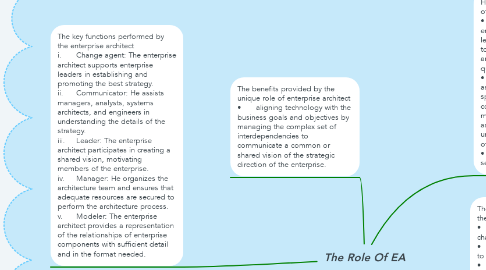The Role Of EA
by Nur Hidayah Abdul Aziz

1. The key functions performed by the enterprise architect i. Change agent: The enterprise architect supports enterprise leaders in establishing and promoting the best strategy. ii. Communicator: He assists managers, analysts, systems architects, and engineers in understanding the details of the strategy. iii. Leader: The enterprise architect participates in creating a shared vision, motivating members of the enterprise. iv. Manager: He organizes the architecture team and ensures that adequate resources are secured to perform the architecture process. v. Modeler: The enterprise architect provides a representation of the relationships of enterprise components with sufficient detail and in the format needed.
2. The benefits provided by the unique role of enterprise architect • aligning technology with the business goals and objectives by managing the complex set of interdependencies to communicate a common or shared vision of the strategic direction of the enterprise.
3. The competencies most needed to be effective in the role i. Change management: To be able to facilitate the implementation of the target enterprise architecture. ii. Communication skills: Critical competence to be an effective enterprise architect who must communicate concepts to people and expressing concepts. iii. Communication skills: A critical competence to be an effective enterprise architect who must communicate concepts to people who are generally pragmatic in their thinking and struggle with understanding and expressing concepts. iv. Communication skills : A critical competence to be an effective enterprise architect who must communicate concepts.
4. How-The architect interface with other roles • interfaces with other enterprise architects at different levels of the enterprise in order to ensure concordance of the architectures and oversees the quality of the EA • with functional groups such as engineers and human resource specialists to better understand constraints or requirements that must be factored into the EA, assist the functional groups in understanding the complexities of the architecture • with senior executives to seek and give advice
5. The impact to the enterprise if the role did not exist • increased potential for chaos and confusion, • inadequate information to support key decision • increased complexity • local versus enterprise optimization • reduced efficiency and effectiveness • increased risk of finding the wrong solution
6. The role most effective within the organizational structure • the data found that the majority of enterprise architects are currently located in the information technology office.


